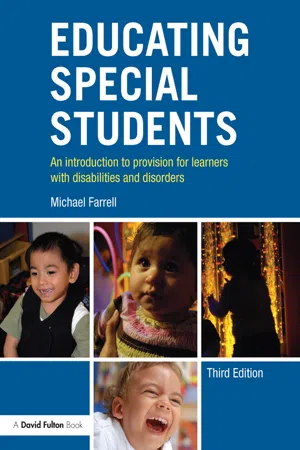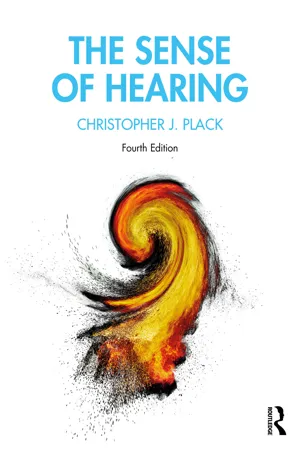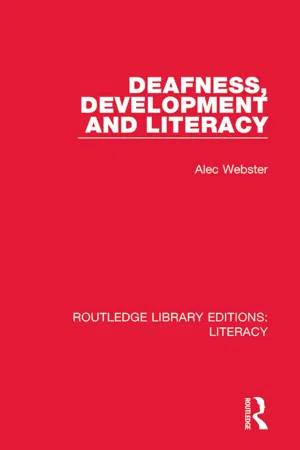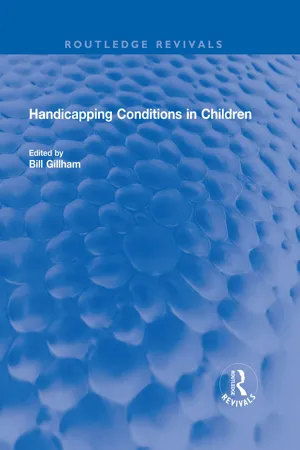Physics
Hearing Defects
Hearing defects refer to any impairment in the ability to perceive sounds. These can range from mild to severe and may be caused by various factors such as genetics, exposure to loud noises, or certain medical conditions. In physics, understanding the mechanics of sound and how it is perceived by the ear is crucial in studying and addressing hearing defects.
Written by Perlego with AI-assistance
Related key terms
7 Key excerpts on "Hearing Defects"
- eBook - ePub
Educating Special Students
An introduction to provision for learners with disabilities and disorders
- Michael Farrell(Author)
- 2016(Publication Date)
- Routledge(Publisher)
sensory–neural deafness, ‘sound’ reaching the inner ear is not properly transmitted to the brain because of damage to the structures within the inner ear or to the acoustic nerve. Defects of the inner ear may be congenital because of an inherited fault in a chromosome; owing to birth injury; or owing to damage to the developing foetus (e.g. because of infection).The inner ear may also be damaged after birth because of severe jaundice or meningitis. Conductive hearing loss is related to a defect in the ‘sound conducting apparatus’ comprising the middle ear or the external auditory canal (Anderson, 2007 , p. 836). Deafness occurs when sound is not properly propagated from the outer ear to the middle ear, usually because of damage to the tympanic membrane (eardrum) or to the bones of the inner ear. A common form of impaired hearing in children is otitis media, an acute inflammation of the middle ear, causing severe pain as well as conductive hearing loss (Kumar and Clarke, 2012 , p. 1049). In otitis media with effusion (glue ear), a sticky fluid collects in the middle ear. Interventions comprise surgically inserting tubes (‘grommets’) into the tympanic membrane to keep the middle ear ventilated; keeping the situation under review, checking hearing regularly and administering antibiotics should acute infections occur; or using hearing aids with open ear moulds (ibid.).Identification and assessment
Early identification and intervention can greatly decrease barriers to learning for children with hearing impairment in the early years. Hearing impairment may be detected early in infancy through neonatal screening or by the parent or health visitor. In later childhood, the school may detect it through routine screening programmes. Screening risk criteria for congenital or early-onset deafness include: - eBook - ePub
- Christopher J. Plack(Author)
- 2023(Publication Date)
- Routledge(Publisher)
- Hearing loss is one of the most significant public health burdens. Since speech perception is impaired, this can have a dramatic effect on quality of life, particularly for the elderly who are most affected.
- Hearing loss is usually characterized clinically by the audiogram, a plot of hearing threshold against frequency. Hearing loss can be divided into conductive, which is a disruption in the transmission of sound from the outer ear to the cochlea, and sensorineural, which is due to dysfunction of the cochlea or auditory nervous system.
- Cochlear damage is the most common cause of hearing loss, usually resulting from dysfunction of the hair cells, in particular the outer hair cells. Cochlear damage results mainly from the combined effects of exposure to loud noises, ototoxic drugs, disease, and the progressive effects of aging. Cochlear hearing loss is particularly prevalent in the elderly, a condition called presbycusis, which is characterized by a progressive decrease in sensitivity to high-frequency sounds with increasing age.
- Extensive inner hair cell loss may lead to a dead region in the cochlea in which information about basilar membrane vibration is not transmitted to the brain. Outer hair cell damage leads to a reduction in the active amplification of basilar membrane vibration, which results in a loss in sensitivity, an abnormally rapid growth in loudness with level called loudness recruitment, and a reduction in frequency selectivity.
- Cochlear hearing loss is associated with impaired pitch perception, which may be a consequence of a combination of deficits in place coding and temporal coding. Importantly, cochlear hearing loss also results in impaired speech perception, particularly in noisy environments.
- Exposure to loud noises and the aging process can cause auditory nerve degeneration without necessarily affecting sensitivity to quiet sounds. Neural declines due to age may also affect processing in the brainstem. These types of subclinical hearing loss
- eBook - ePub
- Alec Webster(Author)
- 2017(Publication Date)
- Routledge(Publisher)
auditory tract to the brain. We can consider this to be the last, but most complicated stage of the journey which sound vibrations make across the hearing system. It is at this point, when information reaches the brain through the auditory pathway, that an individual may decide to do something about the auditory message just received and made sense of.Conductive hearing problemsHearing difficulties can arise if any one of the three sections of the ear we have outlined is not working properly. A major distinction is usually drawn between hearing losses which arise in the conductive mechanisms of the ear, and those which arise in the inner ear as a result of damage to the nerves in the cochlea or auditory tract. However, as we shall see, it is not uncommon for a conductive loss to exacerbate a hearing loss caused by sensori-neural impairment.Generally speaking, a conductive loss is less-severe in its effects although it may have significant implications, particularly for a child in early infancy. Any difficulty which affects the passing or conducting of sound into the ear and across the middle-ear canal may be referred to as a conductive hearing problem. Fortunately, many kinds of conductive difficulties are amenable to medical or surgical treatment which will improve or restore hearing. Not so fortunately, the more severe effects on hearing caused by sensori-neural difficulties are not often able to be remedied. When the nerves of a child’s hearing system are damaged there is no medical treatment which can restore hearing; the damage is permanent.A few conductive hearing difficulties originate at the pinna or outer ear, the very first structure in the three sections of the hearing system. Occasionally, a child may be born with a malformed ear, no outer ear at all, or no ear canal for the sound to pass along. Some thalidomide-affected babies suffered in this way. The problem for hearing sensitivity, when a child is born without external ears or ear canals, is that the sound waves are not channelled efficiently into the inner mechanisms of the ear. If the inner mechanisms are perfectly normal, as they may be, a surgeon might be able to help by creating an outer ear, canal or drum. However, problems with the external features of the ear are frequently associated with malformations of other parts of the system. - Helena Oriešèiková(Author)
- 2015(Publication Date)
- EDUCatt Università Cattolica(Publisher)
b.perceptual impairments (sensorineural, hypacusis perceptiva) caused by the damage of the auditory analyzer in the inner ear, i.e. the part of the auditory analyzer, of which function is the actual perception of sounds (hence the name). This is a malfunction in the organ of Corti and hair cells that convert sound (mechanical signal) into an electromagnetic signal. Sensorineural impairments are further divided into cochlear (localized in the organ of Corti) and supracochlear (localized throughout the further course of the auditory pathway).In the case of perceptual impairments we speak about so-called quality disorder, which means that the level of individual sounds perception is dependent on their frequency. Reducing of this level is not equal in all sounds. Persons with perceptual impairment usually worse perceive high tones, which is practically manifested in the fact that they relatively well perceive ambient noises, voices, but poorly understand speech, because spectra of most speech sounds are characterized just in the area of high tones (formant area) (see Hampl, 2013 Gross, 2009).Perceptual impairments usually represent irreversible and irreparable hearing impairments. The most common causes of sensorineural hearing impairment include age-related partial deafness (presbyacusis), acute or chronic damage of hearing by excessive noise (high risk is the boundary of 80 dB), hearing impairment as a complication of certain infectious diseases (bacterial or viral infections such as meningitis, mumps), congenital syndromes. Other causes include various complications in the prenatal or perinatal period such as a toxic effect of high bilirubin levels in Rh-incompatibility, asphyxia or hypoxia during protracted births, bleeding in the cochlea, low birth weight associated with premature birth etc.c.mixed impairments (hypacusis mixta)- eBook - ePub
The Effective Teacher's Guide to Sensory and Physical Impairments
Sensory, Orthopaedic, Motor and Health Impairments, and Traumatic Brain Injury
- Michael Farrell(Author)
- 2010(Publication Date)
- Routledge(Publisher)
Literacy is examined in the context of an oral and of a sign-bilingual approach. The teaching and learning of mathematics is touched upon and some points are made about general pedagogy. Turning to resources, I describe aids to hearing and look at the provision of cochlear implants. Under school organisation, the chapter considers implications of whether the deaf child is educated in a special school or mainstream school.Definitions
In defining hearing impairment and deafness, two terms require clarification:• frequency • intensity/amplitudeFrequency
Sound is transmitted as a wave in a medium such as air. Air particles are compressed and disturb other particles, enabling transfer of energy. These disturbances are detected by the human ears so that we ‘hear’ sound. In this context it is usual to speak of ‘sound waves’.Frequency concerns the rate at which sound waves vibrate in a specified unit of time. It is usually expressed as cycles per second (c.p.s), although some countries, including the UK, use the term Hertz (Hz.). Sound frequency is perceived as pitch. Rapidly vibrating sound waves are experienced as high-pitched sounds and slower vibrating waves are perceived as low-pitched sounds. The human ear is normally responsive to sounds between 60 and 16,000 c.p.s. It is most responsive to sounds between 500 and 4,000 c.p.s. Owing to the ‘physics and biology of speech and hearing’ speech perception tends to be most affected when frequencies of 500 Hz., 1000 Hz., and 2000 Hz. are affected (Marschark et al., 2006, p. 44).Speech sounds occupy the most responsive band and particular speech sounds involve several frequencies. Vowels usually occupy the lowest frequency range while fricatives, such as ‘s’, ‘f’, ‘th’ and ‘sh’, tend to occupy the higher ones. Hearing loss rarely affects all frequencies equally, so hearing is usually distorted. Where an individual experiences low frequency loss, the ability to hear vowels is impaired. Should there be higher frequency loss, the capacity to hear fricatives and sibilants is reduced. Because consonants make speech intelligible, high frequency hearing loss is usually more serious.Intensity/amplitude
Categorisations of hearing impairment relate to intensity/amplitude. The intensity of a sound is experienced as loudness and is measured in a decibel (dB) scale. On this scale, the quietest audible sound is given a value of 0 dB and the loudest a value of 140 dB. Normal conversation is carried out at around 40 to 50 dB. Individuals with hearing loss of up to 25 dG can be considered to have normal hearing (Ibid. p. 44). Hearing impairment can be measured on the dB scale according to dB loss. In this way, categories of hearing impairment can be made, although the cut off points for the different bands may vary from country to country. The following ranges give a broad indication (Westwood, 2003, p. 48): - eBook - ePub
- B.H Brown, R.H Smallwood, D.C. Barber, P.V Lawford, D.R Hose(Authors)
- 2017(Publication Date)
- CRC Press(Publisher)
Chapter 15Audiology
15.1 Introduction And Objectives
Hearing impairment is very common and arises as a result of factors such as disease, physical accident, exposure to high-intensity sounds, and the process of ageing. Surgical procedures can correct some defects of the middle ear, cochlear implants can be used in some cases of profound hearing loss, and hearing aids can help to overcome defects within the inner ear and the neural pathways, but the hearing loss has to be measured before treatment is planned. Audiometry, or the measurement of hearing loss, forms the major part of this chapter, which concludes with a section on hearing aids.Both technicians and graduate scientists are employed in hearing test clinics to carry out investigations, some of which are simple and others quite complex. Many of the techniques, such as pure-tone audiometry, are well established and routine whereas others, such as evoked-response audiometry, and oto-acoustic emission testing are still developing.Some of the questions we hope to answer in this chapter are:- What determines the range of frequencies that we can hear?
- Can hearing be assessed objectively?
- What determines the shape of an auditory evoked response?
- What limits the assistance that a hearing aid can give to the wearer?
- The steps involved in the process of hearing.
- What defects in hearing can occur.
- The essentials of pure-tone audiometry.
- What is meant by the acoustic impedance of the middle ear?
- Several techniques for the objective assessment of hearing loss.
- The main components of a hearing aid.
This chapter is practical rather than theoretical. Chapter 3 - eBook - ePub
- Bill Gillham(Author)
- 2022(Publication Date)
- Routledge(Publisher)
sensorineural hearing loss. Some hearing impairments are a combination of sensorineural and conductive losses and are known as ‘mixed hearing losses’.Causes of Deafness
Sensori-neural Deafness (Perceptive Deafness)
Sensori-neural deafness can be present from birth (congenital) or acquired during the course of development. In cases of both congenital or acquired sensori-neural hearing losses, where there is permanent damage to the cochlea, auditory nerve or auditory tracks in the brain, there is little hope of alleviating the condition medically or surgically. Such losses can be hereditary, caused by a genetic abnormality, leading to deafness as a single handicap or part of a syndrome. It is estimated that the cause of deafness is genetic in about half the cases of children born deaf. The advice of a genetic counsellor is often sought when such deafness is diagnosed since future children may be similarly affected. Congenital sensori-neural deafness can also result if the mother contracts German measles or another viral infection like influenza, during the first three months of pregnancy. Prematurity or a difficult and arduous birth resulting in an oxygen deficiency, or acute jaundice in which the mother’s blood group is incompatible with that of the foetus, places the child at risk of developing a hearing loss. Acquired sensori-neural hearing losses can result from viral infections in childhood — measles, mumps, influenza, and most commonly meningitis, although the incidence is low and has decreased dramatically over the past 20 years.Conductive Deafness
Most commonly, conductive losses are acquired during infancy, early childhood or adult life, and can be caused by a build-up of wax, a foreign body, or swelling in the outer ear. The majority of conductive-hearing problems, however, are located in the middle ear. Conductive deafness caused by an acute inflammation of the middle ear, acute otitis media, if treated promptly with antibiotics or other medication is usually successfully alleviated, but when the inflammation persists and grows worse a condition known as chronic otitis media develops. This can lead to the eardrum and ossicles becoming inefficient or even damaged. Surgery involving removal and reconstruction of the middleear tissue and bones may be necessary to stop the inflammation from continuing. Secretory otitis media
Index pages curate the most relevant extracts from our library of academic textbooks. They’ve been created using an in-house natural language model (NLM), each adding context and meaning to key research topics.






